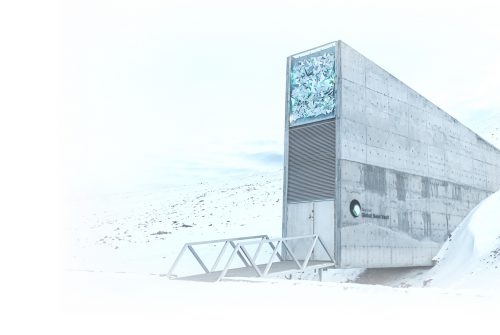The Global Seed Vault is in danger
2 April 2019 | Written by Eleonora Cogo
The largest seed bank in the world risks being compromised by climate change

Buried deep in the heart of a mountain on a remote island of the Svalbard archipelago, halfway between the coasts of Norway and the North Pole, is the Svalbard Global Seed Vault, the largest seed bank in the world. Designed to withstand natural and man-made disasters, it could now be at risk due to the impacts of climate change.
The Svalbard Global Seed Vault. Opened on February 26, 2008, the Svalbard Global Seed Vault stores copies of seeds on behalf of gene banks from around the world. The site provides a sort of back-up service to preserve genetic diversity, enabling seeds to be replaced in the event of accidental losses due, for example, to a war or a major disaster, or simply because of a refrigerator malfunctioning.
ICARDA, the International Center for Agricultural Research in Dry Areas, has already made one withdrawal. In 2015, due to the ongoing conflict in Syria, it had to abandon its headquarters in Aleppo where 150,000 cereal, food and feed seed samples were stored. Fortunately, most of those samples were also held in the Svalbard depository.
The depository extends deep inside the mountain. At the end of a 120-meter long tunnel are the rooms which contain the seeds. The environment is kept at a constant temperature of -18 ° C with low humidity levels to ensure optimal conditions for maximum seed longevity. The permafrost and the surrounding rock also help to ensure that the samples will remain frozen, even in the event of a blackout.
The site has the capacity to store 2.5 billion seeds. Today, it contains a million samples, coming from almost every country in the world. There are unique varieties from Africa and Asia such as maize, rice, wheat, bean and sorghum, and European and South American varieties of eggplant, lettuce, barley and potatoes. That makes it the most diverse collection of seeds and food crops in the world.
Climate risks. This site was selected because of the cold climate and the presence of permafrost, which also made it an ideal place for the installation of underground refrigerated rooms. However, temperatures are rising at an alarming rate in the Arctic. The city of Lonyearbyen, near the Svalbard Global Seed Vault, is warming faster than any other city on the planet. According to the “Climate in Svalbard 2100” report there has been a temperature increase since the beginning of the last century of 3.7 ° C, more than triple the global average of approximately 1 ° C.
The report, commissioned by the Norwegian Environmental Agency, also underlines how the average temperature could increase by 7-10 º C by the end of the century. It also shows that there will be a rise in annual precipitation of 46-65% and a shortening of the winter season, which could increase the risk of erosion, avalanches and melting of the permafrost.
A couple of years ago, due to very intense rains, an infiltration of water actually reached the entrance of the depository. The water inside froze and, fortunately, did not reach the seeds inside, but the incident raised concerns about the site’s capacity for safeguarding its precious contents.
The Norwegian government immediately put in place plans to make the depository more resilient to a wetter, warmer climate. Works were commissioned at a cost of NOK 100 million (approximately EUR 10 million) that included the construction of a new waterproof concrete access tunnel to the site and the creation of a separate service building that contains, among various heat sources, an additional refrigeration unit.
One of the major worries remains the thawing of the permafrost, which could put at risk the stability of the frozen ground within which the structure is built. As highlighted in the last IPCC assessment report, the melting of permafrost also has the side effect of releasing into the atmosphere large amounts of methane, a powerful greenhouse gas, which would cause further warming of the atmosphere.
This is a vicious circle that can be broken only by the urgent reduction of greenhouse gas emissions from human activities. That would help keep the Svalbard Global Seed Vault safe and dry. It is the only back up for protecting the genetic diversity of the world’s food for future generations. At the same time, it could help them cope with the challenges of climate change and the growth of the global population.


